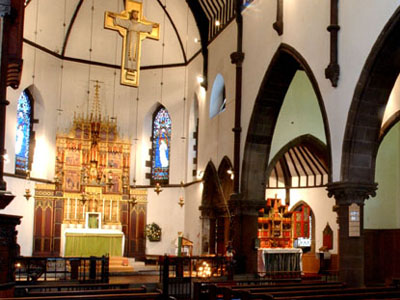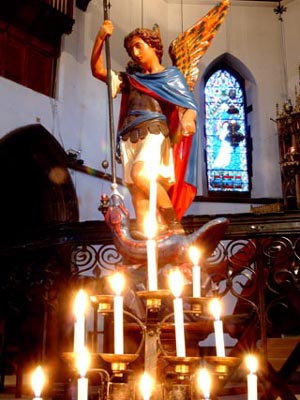 |
|

The church: St Michael and All Saints, Edinburgh, Scotland.
Denomination: Scottish Episcopal Church.
Comment: We have received a comment on this report.
The building: The building dates from 1866 and was originally dedicated in honour of All Saints. Nearby St Michael's closed in the 1960s, and the two parishes merged to form the current St Michael and All Saints. In addition to the high altar are the Lady chapel altar to the north and another to the south, perhaps dedicated to St Michael, as there are both a statue and an icon of the archangel nearby. There are seven hanging sanctuary lights, the central one of which is the sacrament light. These do wonders for the sanctuary, which has also benefited from the quire being used as an extended sanctuary (the choir itself sings from the north transept).
The church: An Anglo-Catholic parish. The different needs that this church caters to are reflected in the times of the masses throughout the week, which are at a different time each day. They also have choral evensong and benediction every Sunday evening. The congregation appeared to be a healthy spread of ages.
The neighbourhood: This church is in the heart of city centre Edinburgh, among pubs, eateries, a park and various businesses, yet partly surrounded by city centre residences as well.
The cast: The Very Rev. Kevin Pearson, rector, was the celebrant and preacher.
High Mass (First Sunday after Trinity).
How full was the building?
We were sitting near the front and so it was somewhat hard to tell, but I would estimate about 50 people.
Did anyone welcome you personally?
Yes. There were sidesmen who wished us a good morning and gave us our hymnals and service books.
Was your pew comfortable?
Yes. I often hear and read complaints about pews, but I have very rarely had any negative experiences with them. I often wonder whether habitual pew-sitting leads to reduced sensitivity to pain.
How would you describe the pre-service atmosphere?
Prayerful. There really isn't much more to be said. The organ played and the people sat, quietly preparing for the sacred mysteries.
What were the exact opening words of the service?
"In the name of the Father, and of the Son, and of the Holy Spirit. Amen." The priest delivered the notices before mass began and threw in a few quips, thus setting a joyful mood. I think that this is perhaps the best time for the notices rather than having them interrupt the liturgy as in many churches.
What books did the congregation use during the service?
The liturgy was printed in an exquisite home-produced, spiral-bound book, which included the entire text of all of the regular services at St Michael's. There were rubrics indicating changes in posture as well as bowings and crossings. The book also included music for the sung parts of the mass, including the gloria from Martin Shaw's Anglican Folk Mass and Merbecke's Creed, among others. The hymnal was the New English Hymnal, words edition. I asked if it would be possible to have a music or melody edition but was frostily informed that "We don't give those to the congregation."
What musical instruments were played?
The instrument par excellence of the western rite – the organ – and played most superbly at that.
Did anything distract you?
Yes. During the singing of the gloria and creed, I kept stumbling over the words because I was not paying attention. The texts in the Scottish Episcopal liturgy are sufficiently similar to those of the 1662 Prayer Book so as not to make the differences immediately obvious at first glance, yet sufficiently different to cause anyone not paying close attention to stumble.
Was the worship stiff-upper-lip, happy clappy, or what?
The worship had a relaxed formality which, in my opinion, is the mark of good Catholic worship. The service was described as high mass, but there was no deacon or subdeacon assisting, and so it would perhaps be more accurately called sung mass. It was based on the Scottish Episcopal Liturgy 1970, but with traditional additions such as the Orate Fratres, for which the English Missal translation of the Tridentine version was used.

Exactly how long was the sermon?
12 minutes.
On a scale of 1-10, how good was the preacher?
10 – Concise, warm and accessible without being patronising.
In a nutshell, what was the sermon about?
The sermon was centred around the first reading, which was the Genesis account of the flood. Father Pearson likened the ark to the Christian faith – a stronghold in time of trouble, but also subject to the effects of turbulent times. Creation is one ongoing act of God, in which God imposes order on chaos, and this permeates our lives. Modern life is stressful, and we can often feel that we are drowning. We must hope and trust in God's love, which not only rescues us from the chaotic waters of life, but also shows us the beauty of life.
Which part of the service was like being in heaven?
It was wonderful to go to a sung mass that was offered with the priest facing east, "priest and people together, facing the same way, in a common act of worship, symbolising our common pilgrimage towards the returning Lord, the Sun of Justice." The music was also fantastic: the small but magnificent choir sang all of the plainsong propers from the mass except the communion, where they sang Ralph Vaughan Williams' O Taste and See instead. We sang some right good hymns as well, climaxing with Hail Redeemer, King Divine! at the recessional. Finally, we were impressed at how the thurifer guided the young (and perhaps new) boat-bearer so that he never felt lost.
And which part was like being in... er... the other place?
Call me fussy, but I don't like to see the indigenous traditions of British Catholicism rejected in favour of continental traditions. Things like six lights on the altar, the tabernacle, cottas, crossing oneself at the end of the creed, genuflecting, and other such traditions – continental imports all of them – have superseded those that already existed in Britain. At face value these are insignificant, but on a deeper level they seem to imply that only certain Catholic traditions are valid, and the ones that nurtured and fed our ancestors are inferior. This saddens me.
What happened when you hung around after the service looking lost?
This would never happen, as my nature is such that I cannot stand around looking lost. My friend and I were complimented on our singing by the lady and gentleman who were sitting in the pew in front of us. I later approached the organist and had a brief but warm conversation with him about the music. We had a look around the building and got to talking with the master of ceremonies about incense. It was all very warm and friendly, yet without being intrusive – a good balance. I liked it a lot.
How would you describe the after-service coffee?
We didn't stay. The weather was lovely, and many people had gone outside to enjoy the sun and to smoke (as though they hadn't inhaled enough smoke during the liturgy), so we joined them for a while and then went to get some lunch.
How would you feel about making this church your regular (where 10 = ecstatic, 0 = terminal)?
8 or 9 – This is a good community. Worship is primarily God-focused and not congregation-focused, and it is consequently done exceptionally well. I love singing plainsong and good, traditional hymns, and all of these are an intrinsic part of the worship there. If it weren't for what I think is an unhealthy approach to indigenous Catholicism, I could make this my home very easily were I to live in Edinburgh.
Did the service make you feel glad to be a Christian?
Most definitely.
What one thing will you remember about all this in seven days' time?
The awe, wonder and splendour of the mass offered facing east, looking out to that which is beyond the gathered community – to eternity.
| The Mystery Worshipper is sponsored by surefish.co.uk, the internet service provider from Christian Aid. By offering email services, special offers with companies such as amazon.co.uk and smile.co.uk, surefish raises more than £300,000 a year for Christian Aid's work around the world. Click here to find out how to become a Mystery Worshipper. And click here if you would like to reproduce this report in your church magazine or website. Top | Other Reports | Become a Mystery Worshipper! © Ship of Fools 2005 |